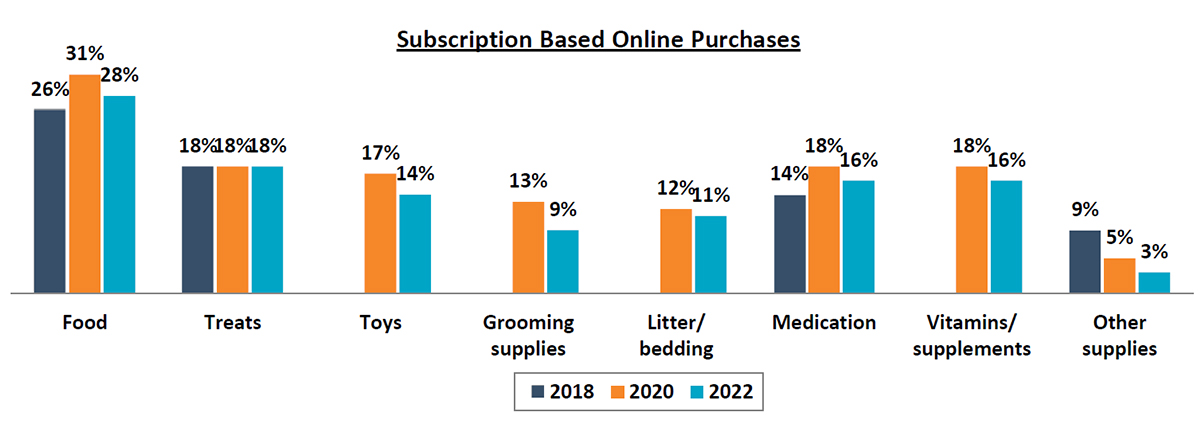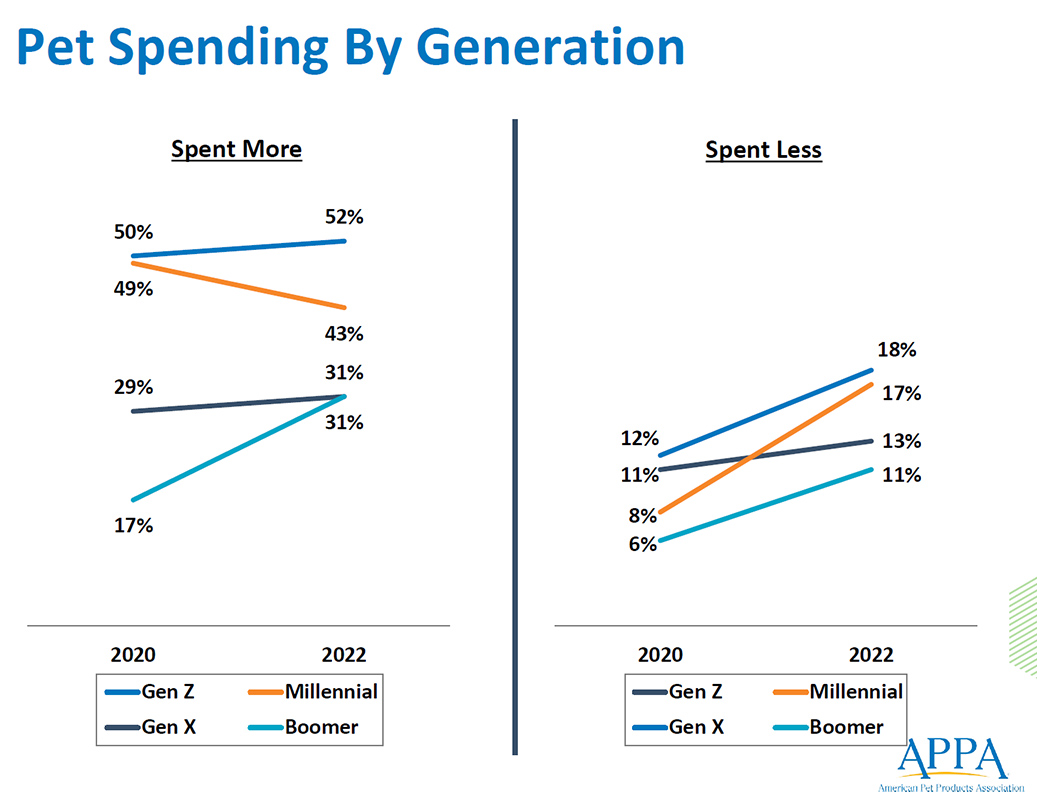Read more from APPA’s Global Pet Expo 2023 presentation in our other article, “Pet owners seeking out these key food, treat attributes.”
ORLANDO, FLA. — According to the American Pet Products Association’s (APPA) 2023-2024 National Pet Owners Survey, the number of US households that own at least one pet is now 86.9 million, making up 66% of households nationwide. This pet ownership is now reflected equally among younger and older generations of pet owners; for the first time, APPA reported, the number of Gen Z and Millennial pet owners equals the number of Gen X and Baby Boomer pet owners across the country.
Julie Springer, market research analyst at APPA, shared top-level findings from the report, including insights on the modern pet owner, generational pet ownership shifts and channel preferences, at Global Pet Expo 2023, held March 22 to 24 in Orlando.
Channeling the modern pet owner
According to the report, 38% of pet owners typically purchase their pet products in person at a brick-and-mortar store, compared to 34% who buy online and have them shipped directly to their homes. In the spirit of omnichannel, 12% of pet owners browse online but buy in-store, 7% browse in store and buy online, and 7% buy online and pick them up at a local store.
APPA shared 90% of pet owners have made some type of online pet product purchase over the last 12 months, but pandemic-era acceleration of this trend has since slowed. Food and treats are two popular pet product categories for online purchasing, with 80% of pet owners purchasing their pets’ food online and 76% purchasing treats online in 2022. This represents a notable increase from 59% and 56%, respectively, in 2018.
According to APPA, 42% of pet owners who purchase pet food online have the products shipped directly to their homes, while 46% pick them up inside the store and the remaining 13% pick them up curbside. Similarly, for those who purchase treats online, 39% have them shipped to their homes, 49% pick them up inside the store, and 13% pick them up curbside.
Subscription-based purchasing has emerged as a convenient option for online pet product shoppers, although the popularity of this method has remained stagnant for treats and declined for food from 2020 to 2022. According to APPA, 28% of pet food shoppers utilized subscription-based services in 2022, down from 31% in 2020, while 18% of pet treat consumers chose this online ordering route, a figure that has gone unchanged since 2018.
 Source: American Pet Products Association
Source: American Pet Products Association In 2022, 50% of pet owners claimed their online pet product purchasing habits stayed the same over the last 12 months, while 42% said they made more online purchases and 8% said they made less. Moving through 2023, 31% of pet owners said they plan to utilize online purchasing with direct home delivery more, while 19% said they plan to order online and pick up inside the store more frequently, and 16% plan to leverage curbside pickup more often.
Surfing for pet products
Pet product consumers clearly have not abandoned the brick-and-mortar channel, but the evolution of e-commerce and omnichannel retail options will continue to influence how pet parents shop for — and discover — the products that may end up in the checkout line, albeit in-person or virtual.
According to APPA, the most common way pet owners become aware of new products is by browsing in a store (52% of pet owners in 2022), but surfing the internet comes in at a close second, with 45% of pet parents taking these efforts online. Social media (38%), friends and relatives (38%) and TV ads (35%) are also sources of new product awareness. The report revealed that pet store personnel (28%) and veterinarians (27%) were the least common, although these resources have become slightly more popular for new product awareness since 2020 (at 24% and 26%, respectively).
Half (50%) of pet owners look to the websites of pet product companies to become aware of and find information about new products, up from 45% in 2020. This is followed by YouTube, with 45% of pet owners using the platform to learn about new products, as well as retailer websites (43%), Facebook pages (42%), product review sites (33%), Instagram (32%), TikTok (25%, which has grown in popularity from 14% in 2020), and Twitter (18%). Other sources include Pinterest (18%), blogs (12%) and Snapchat (11%).
Generational pet ownership
According to APPA, 50% of US households owned at least one dog in 2022, and 35% owned at least one cat. For the first time, Springer noted, pet ownership is split down the middle between younger and older generations, marking a transition point where Millennial and Gen Z pet owners will begin to have more sway over the direction of the industry in years to come.
Pet ownership among the two youngest generations rose steadily from 2018 to 2022. According to APPA, 11% of Gen Z owned a pet in 2018, which rose to 14% in 2020 and 16% in 2022. Additionally, 31% of Millennials owned a pet in 2018, which rose to 32% in 2020 and 33% in 2022.
For older pet parents, pet ownership has fluctuated over this period. For example, 26% of Gen X owned a pet in 2018, which fell to 24% in 2020 and rose slightly again in 2022 to 25%. Roughly 29% of Baby Boomers owned a pet in 2018, which fell to 27% in 2020 and 24% in 2022. Pet ownership has also fallen among the oldest generation — Builders — with 4% owning a pet in 2018, 3% in 2020 and 2% in 2022, according to APPA.
Approximately 36% of Millennial pet parents own a dog or cat, compared to 17% of dog-owning Gen Z pet parents and 15% of Gen Z who own cats. Among Gen X, 24% own dogs and 25% own cats. Additionally, 22% of Baby Boomers own dogs and 23% own cats.
An increasing number of pet owners — regardless of generation — reported spending less on pet products from 2020 to 2022. Millennials reported the highest shift, with 17% spending less in 2022 compared to 8% spending less in 2020, followed by Gen X, with 18% spending less in 2022 compared to 12% spending less in 2020. A growing number of Baby Boomers (11%) also reported spending less in 2022, compared to just 6% in 2020. The number of Gen Z pet owners who reported spending less in 2022 changed slightly from 11% in 2020 to 13% in 2022.
 Source: American Pet Products Association
Source: American Pet Products Association Baby Boomers saw the most notable reported increase in pet spending, with 31% reporting they spent more in 2022 compared to 17% who spent more in 2020. Increased spending for Gen X and Gen Z was incremental, while 43% of Millennials reported spending more in 2022, compared to 49% who spent more in 2020.
Overall, most pet owners (46%) maintained their pet spending from 2021 to 2022, with 25% spending a little more, 13% spending a lot more, 12% spending a little less, and just 3% spending a lot less.
Regardless of these generational shifts, the vast majority (75%) of pet owners are unwilling to curtail their spending on pet nutrition, agreeing with the statement: “My pet’s diet is very important to me, so I do not plan to make changes regardless of finances/the economy.”
Read more from APPA’s Global Pet Expo 2023 presentation in our other article, “Pet owners seeking out these key food, treat attributes.”





